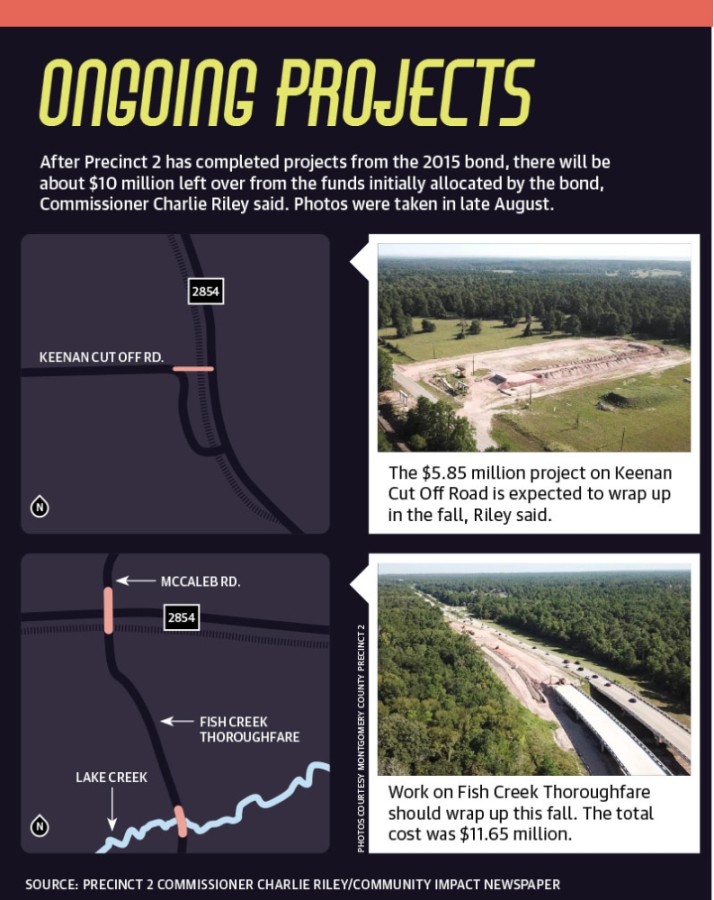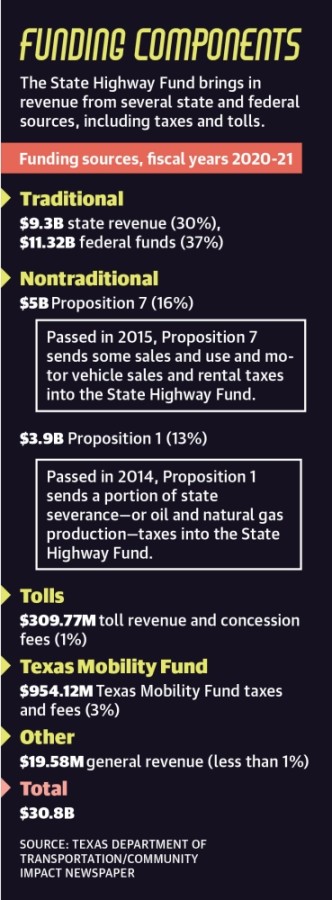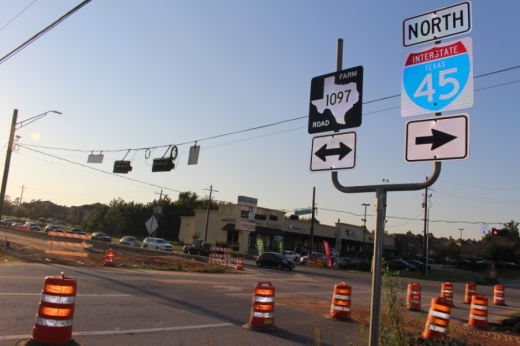“We were just doing so well,” Precinct 2 Commissioner Charlie Riley said. “We all kind of had in the back of our mind that once we get these road projects [from the 2015 bond] done ... we were possibly going to ask to go out for another bond.”
Then COVID-19 hit. State oil and gas and sales tax revenues tanked. And state representatives now face an estimated $4.58 billion budget shortfall when they convene for the 87th Texas Legislature in January.
Officials said it is unclear how transportation projects across the state—which are already squeezed for revenue—will be funded in the next few years.
“The pandemic has really hurt all of the primary sources for transportation revenue,” said Aaron Cox, vice president of the advocacy group Texas Association of Business. “It was really kind of a double-barrel assault.”
Montgomery County has funded its recent road projects—including the expansion of FM 1097 in Precinct 1—largely through a $280 million road bond passed in 2015. In May, each of the precincts had between $9.4 million and $68.7 million leftover of the funds originally provided to them, although officials did not return requests for an update.
County Judge Mark Keough said in May they would discuss the need for another bond after the thoroughfare planning was complete, which will be in summer 2021, a representative from Brown and Gay Engineering said at the Oct. 13 commissioners court meeting. But talks of a bond have been tabled because of the pandemic, Riley said, and local transportation groups said future projects that involve state funding could be affected in the next two to three years.

“How significant they will be, I don’t think anyone quite has a handle on that yet,” said Allie Isbell, transportation manager for Houston-Galveston Area Council, which secures federal and state funding for local projects. “But there will be a dent.”
A historic drop
Despite recent efforts by voters and lawmakers to improve transportation funding, funding for Texas roads has not kept up with demand, Cox said, and this has been exacerbated by the pandemic.“Before COVID[-19], ... infrastructure development wasn’t keeping pace with our state’s population and economic growth,” he said. “Our roads and bridges need constant improvement and maintenance. It’s an ongoing issue.”
Texas voters approved a pair of statewide propositions—Proposition 1 in 2014 and Proposition 7 in 2015—that diverted portions of oil and gas severance taxes, general sales taxes and motor vehicle sales taxes to the State Highway Fund, which is TxDOT’s primary source of funding.
However, the State Highway Fund is projected to see its state share of revenue fall 20.44% and its federal income reduced more than 12% from 2020-21, good for an overall 17.13% drop in fund revenue in that time, according to the state comptroller.
Texas Comptroller Glenn Hegar told state officials July 20 to expect a historic drop in state revenue by the end of fiscal year 2020-21, with motor vehicle sales tax revenue and severance tax revenue among the hardest hit. The highway fund is projected to get about $1.1 billion in transfers this fiscal year based on collections from the previous fiscal year, but next year’s transfer—which will be based on collections this year—is projected to fall to $620 million, Hegar said.
“With any revenue impact, TxDOT will fully assess future plans and adjust accordingly,” TxDOT Director of Media Relations Veronica Beyer said in an email.
Local projects
Although the pandemic’s effects on statewide transportation funding may not be clear until the Legislature’s spring 2021 session or later, road projects in Montgomery County and across the state remain on schedule or have even accelerated. Lower traffic due to the lockdown helped crews work faster, Andrea French, executive director of the Transportation Advocacy Group Houston, said.“You’ll see projects where they weren’t supposed to be completed for a year; their timeline has been moved up six months,” she said.
One project in Precinct 1 still underway is the expansion of FM 1097 from two lanes to four, which has been part of Precinct 1 Commissioner Mike Meador’s work since 2005, Meador said in May. Four segments of the road are projects from the 2015 bond, totaling roughly $17 million and slated for completion by September 2021.
After Precinct 1 has completed ongoing projects from the 2015 bond, there will be about $150,000 left over from the funds initially allocated by the bond, Meador said in May. Riley said he estimates Precinct 2 has about $10 million remaining from the bond allocation, which will go toward extra projects in the precinct.
Officials have historically targeted the county’s east and west corridors, such as FM 1097, Hwy. 242 and Hwy. 105, as areas that need to be widened to relieve congestion, Riley said.
“All of those roads are at capacity, or near capacity or over capacity, and those are the ones that we’re going to have to look at to try to expand before we try to put something new on the ground right now,” Riley said.
TxDOT’s access management study of FM 1488 from Magnolia to I-45 concluded this spring, resulting in the recommendation of $19 million in enhancements within five years.
And the agency’s I-45 planning and environmental linkage study, covering the highway from Houston to Conroe, is expected to bring proposed improvements for the county’s central corridor by late 2021.
Meanwhile, the city of Conroe’s transportation projects will likely not be affected by declining state revenue, said Tommy Wolley, the city’s director of capital projects and transportation. Most of its projects have been awarded federal and state funds already, such as the $121.48 million extension of Old Conroe Road to Conroe across the West Fork of the San Jacinto River, which is expected to wrap up in 2025.


The city has its own thoroughfare plan that identifies general locations for future roads, although timelines and costs are not established. Two future projects added to the plan in 2019 would extend Park Dale Drive south to Crighton Road east of the railroad tracks and extend Mike Meador Boulevard to Hilbig Road.
Looking for revenue
Transportation advocacy groups said they are pushing for long-term solutions to address the funding gridlock on Texas roads, such as allocating additional revenue sources.Transportation Advocacy Group Houston is advocating for several options for new revenue sources, French said. One is to collect a fee from users of alternatively fueled vehicles. The other is to lift the cap on sales tax, which is set at 8.25%, so cities and counties would have the flexibility to raise it.

The third—to either raise or at least index the gas tax rate for inflation—is an idea that has historically been met with pushback, French said. The state’s gas tax has not been changed or indexed to inflation since the 1990s, but adjusting it could help fund transportation budgets.
“There was a time when even more conservative leaders supported it, but now the word tax has become such a dirty word to use; it gets swept up in those conversations,” French said. “There are [always] at least a few legislators that introduce something for the gas tax, but it never gets very far.”
It is unclear how Montgomery County will fund its future road projects. Keough, Precinct 3 Commissioner James Noack, Precinct 4 Commissioner James Metts and Meador did not respond to requests for comment. Keough had previously said bond discussions might come in late 2020 or early 2021.
French said bonds are the traditional way to compliment state and federal funding for local projects.
“If you really prioritize local projects, bonds are the best way to do it,” she said.
But Riley said a pandemic is not the right time to put a bond on a ballot.
“This is just not the time to even be thinking about going out for another road bond,” he said. “So I’m sure that’s been pushed for a year, maybe two years.”
Additional reporting by Andy Li, Shawn Arrajj, Andrew Christman and Anna Lotz






